May 2009 LIP of the Month
860-750 Ma Large Igneous Provinces in South China: Record of Plume Events During the Breakup of the Supercontinent Rodinia
Zheng-Xiang Li1, Xian-Hua Li2,3, Xuan-Ce Wang2,3, Wu-Xian Li3, Qiang Wang3
- The Institute for Geoscience Research, Department of Applied Geology, Curtin University of Technology, GPO Box U1987, Perth, WA 6845, Australia; Z.Li@exchange.curtin.edu.aui
- State Key Laboratory of Lithospheric Evolution, Institute of Geology and Geophysics, Chinese Academy of Sciences, P.O. Box 9825, Beijing 100029, China
- Key Laboratory of Isotope Geochronology and Geochemistry, Guangzhou Institute of Geochemistry, Chinese Academy of Sciences, Guangzhou 510640, China
Corresponds in part to event 67 in LIP record database
Neoproterozoic magmatism, including plutons, dyke swarms and volcanics, are widespread in South China (Fig. 1). However, their tectonic significance remains controversial. The traditional view was that the plutons signify the "cratonization" of the Yangtze Craton (e.g., (Wang and Mo, 1995). However, precise geochronology has demonstrated that a vast majority of the plutons are coeval with continental rifting events, predominantly between 825 Ma and 750 Ma (Liu, 1991; Li et al., 1999; Li et al., 2003a, 2003c; Wang and Li, 2003).
Li et al. (2003c) demonstrated that after a possible early start at ca. 860-850 Ma, Neoproterozoic magmatic events in South China exhibit four major peaks: ca. 825 Ma, ca. 800 Ma, ca. 780 Ma and ca. 750 Ma. More ages on all age groups have been reported in recent years. In particular, Li et al. (2003b, 2006, 2008b) demonstrated that anorogenic magmatism started at 860-850 Ma in South China. Although the anorogenic interpretation for the 860-750 Ma magmatism is not universally accepted (for alternative views see Wang et al., 2006 and Zhou et al., 2002b), here we present these rocks as products of plume-induced magmatism, particularly for those dated at 825-750 Ma because 860-850 Ma magmatism is not as widespread or well studied. Some of the magmatic events are also found in the southern Korean Peninsula, an extension of the South China Block.
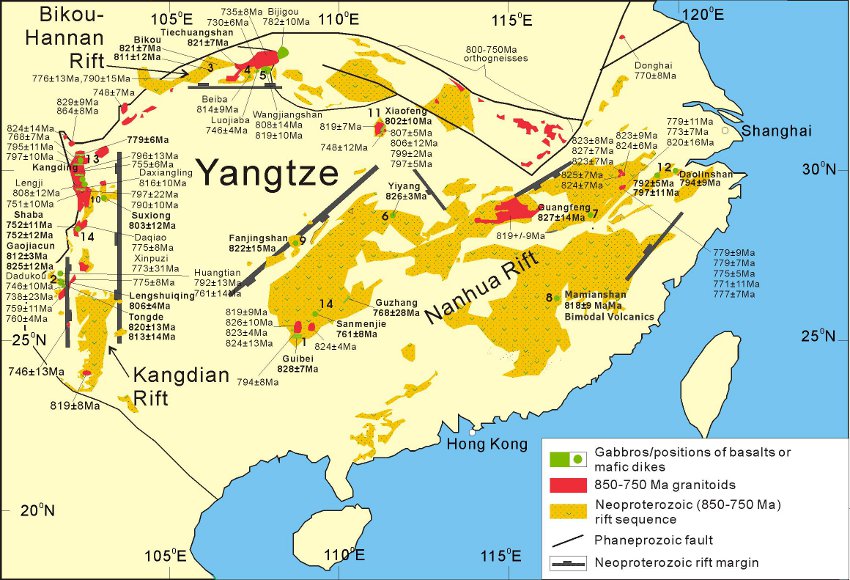
Figure 1: A schematic diagram showing the distribution of the 825-750 Ma magmatic rocks and continental rift systems in South China (after Li et al., 2003a; Li et al., 1999; Li et al., 2003c).
Ca. 825 Ma magmatism: the Guibei LIP
The Guibei LIP covers products of a major bimodal magmatic event in South China. Mafic-ultramafic rocks include the 828 ± 7 Ma mafic-ultramafic dykes in Guibei (marked as #1 in Fig. 1; Li et al., 1999), the ca. 825-810 Ma Tongde-Gaojiacun complex (#2 in Fig. 1; Sinclair, 2001; Zhou et al., 2006; Zhu et al., 2006), the 821 ± 7 Ma to 811 ± 12 Ma Bikou Group basalts (#4 in Fig. 1; Wang et al., 2008), the 821 ± 7 Ma Tiechuanshan basalts (#4 in Fig. 1; Ling et al., 2003), the 820-810 Ma Wangjiangshan complex (#5 in Fig. 1; Zhou et al., 2002a), the 826 ± 3 Ma Yiyang komatiitic basalts (#6 in Fig. 1; Wang et al., 2009), the 827 ± 4 Ma basalts at Guangfeng (#7 in Fig. 1; Li et al., 2008a), and the 818 ± 9 Ma Mamianshan basalts (#8 in Fig. 1; Li et al., 2005). There are also numerous granitic intrusions of that age in both the interior and along the margins of the Yangtze Craton, and felsic volcanic and volcani-clastic rocks in the continental rift systems (Li et al., 2003a; Wang and Li, 2003).
The largest basaltic outcrop is the Bikou Group volcanics close to the present northwestern margin of the South China Block (#4 in Fig. 1). It covers an area of ~10,000 km2, with an estimated kilometres-thick of predominantly tholeiitic basalts (Wang et al., 2008). Well-preserved pillow structures are found at a number of successions (e.g., Fig. 2).
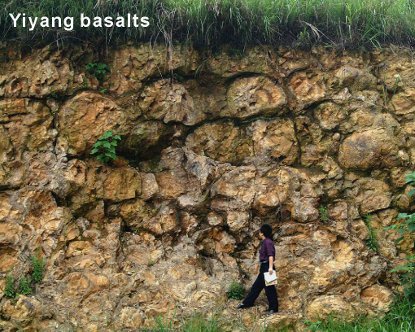
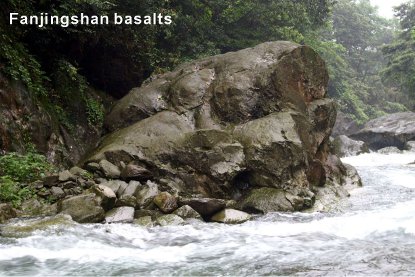
Figure 2: Pillow structures in the Yiyang komatiitic basalts (#6 in Fig. 1; Wang et al., 2007) and the Fanjingshan basalts (#9 in Fig. 1)
A mantle plume origin for this episode of bimodal magmatism was based on a number of geological, geochemical and geochronological observations, such as evidence for syn-magmatic doming, the bimodal and intraplate nature of the magmatism (see summary of geochemical characteristics below), and their associations with continental rifting (e.g., Li et al., 1999, 2003a, 2003c). More recent work by Wang et al. (2007, 2008) demonstrate that both the 826 ± 3 Ma Yiyang komatiitic basalts and the 811 ± 12 Ma upper Bikou basalts have mantle potential temperatures over 1500°C (Fig. 3).
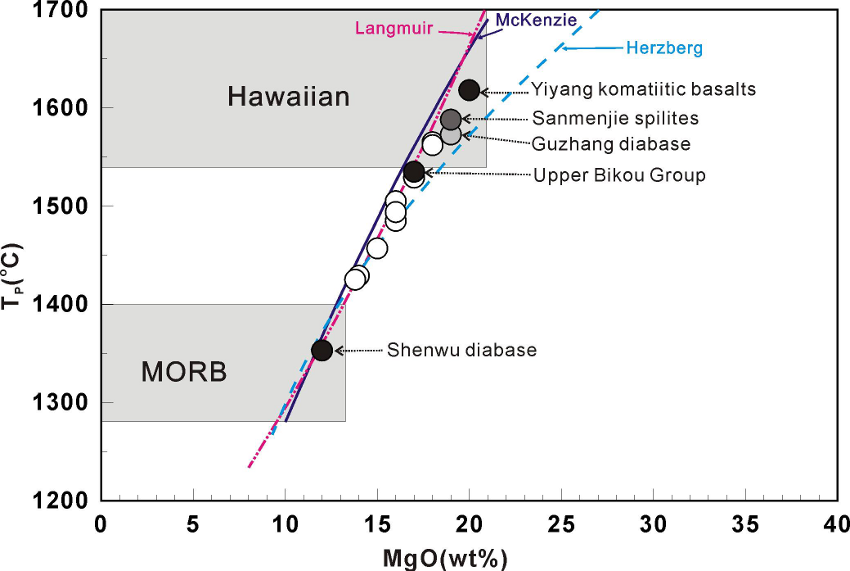
Figure 3: Mantle potential temperatures (Tp) as a function of the MgO concentrations of primary magmas (after Wang et al., 2009, modified from Herzberg et al., 2007).
Zhou et al. (2009) recently reported 822 ± 15 Ma basalts at Fanjingshan (#9 in Fig. 1; Fig. 2), but they interpret the rocks to be of arc origin. However, we notice that the basalts show no Zr and Hf depletion relative to Sm (as in Fig. 8c-d of Zhou et al., 2009), unlike typical arc basalts (e.g., McCulloch and Gamble, 1991). The Nb-Ta negative anomaly in the Fanjingshan basalts thus likely results from crustal or sub-continental lithospheric mantle contamination (Li et al., 2007; Wang et al., 2009). Indeed, plume-related low-Ti continental flood basalts (CFBs) often show Nb-Ta negative anomalies (Turner and Hawkesworth, 1995; Hawkesworth et al., 2000; Puffer, 2001). The Fanjingshan basalts are also alkaline basalts (Fig. 6a), and therefore should not be classified as calc-alkiline basalts.
Ca. 800 Ma magmatism: the Suxiong-Xiaofeng LIP
The Suxiong-Xiaofeng LIP is represented by the 803 ± 12 Ma Suxiong-Kaijianqiao bimodal volcanics in the Kangdian Rift (#10 in Fig. 1; Li et al., 1999; Li et al., 2002; Wang and Li, 2003), the 802 ± 10 Ma Xiaofeng composite dykes (Li et al., 2004), the 794 ± 9 Daolinshan granite-diabase complex and the 792 ± 5 Ma Shangshu bimodal (basalt-rhyolite) volcanic rocks (Li et al., 2008b), and equivalent plutonic and volcanic rocks elsewhere. The Suxiong-Kaijianqiao bimodal volcanic succession is up to 10 km thick, and the Shangshu Group, dominately basalts, is up to 2.5 km thick.

Figure 4: The 802 ± 10 Ma Xiaofeng dykes intruding the 819 ± 7 Ma Huangling granite (Li et al., 2004).
Ca. 780 Ma magmatism: the Kangding LIP
Products of the Kangding events include the roughly E-W trending, 779 ± 6 Ma to 768 ± 7 Ma mafic dykes that intrude coeval granitic rocks in the Kangding region (#13 in Fig. 1, also Fig. 5; Li et al., 2003c; Lin et al., 2007), and numerous coeval granitic and volcanic units throughout the South China Block (Fig. 1).
Ca. 750 Ma magmatism: the Shaba LIP
The ca. 750 Ma event was widespread in South China, with mafic examples that include the Shaba gabbro (#14 in Fig. 1; Li et al., 2003c), the Sanmenjie spilites and gabbros, and the Guzhang mafic dykes (#14 in Fig. 1; Zhou et al., 2007). Both the Sanmenjie spilites and the Guzhang mafic dykes indicate high mantle potential temperatures (Fig. 3; Wang et al., 2009).
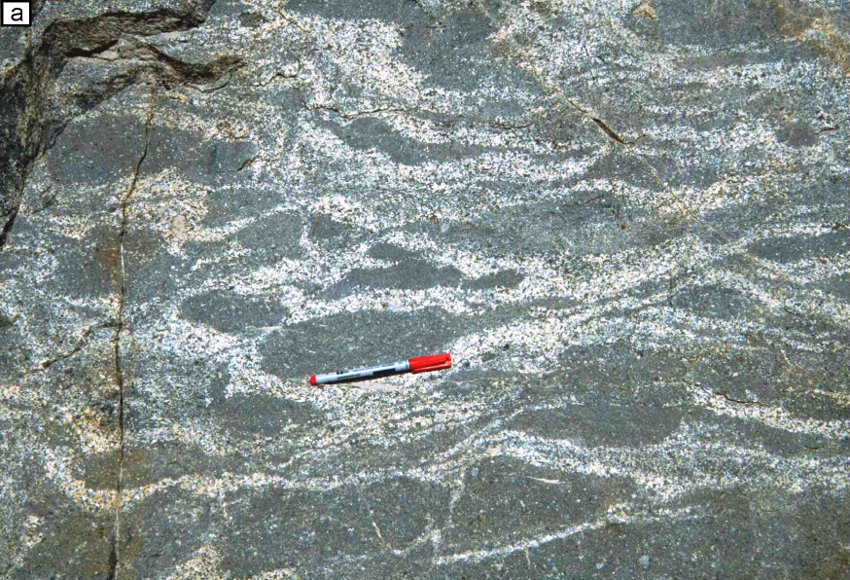
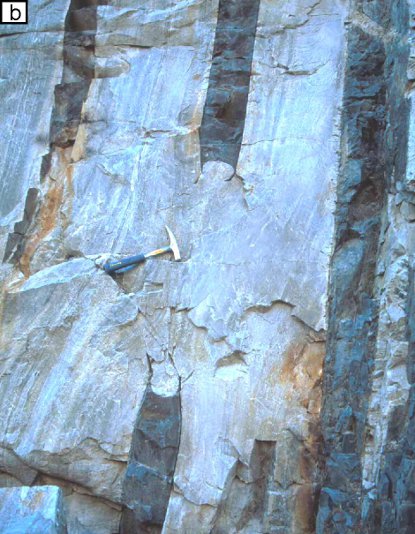
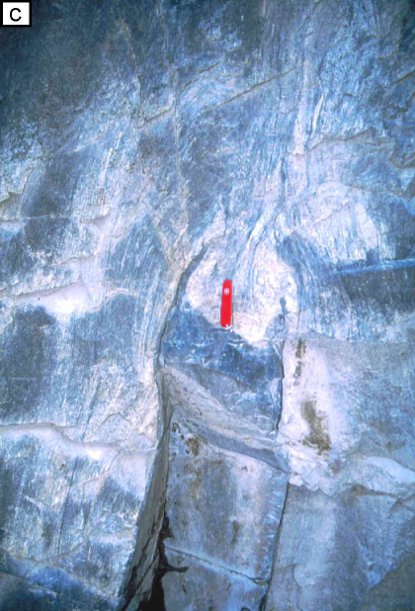 Figure 5: Photos of 779 ± 6 Ma to 768 ± 7 Ma magma mingling (a), and ductile interaction between mafic dykes and the intruded granitoid when they both were in semi-solid states (b, c) in the Kangding region (Li et al., 2003c; Lin et al., 2007).
Figure 5: Photos of 779 ± 6 Ma to 768 ± 7 Ma magma mingling (a), and ductile interaction between mafic dykes and the intruded granitoid when they both were in semi-solid states (b, c) in the Kangding region (Li et al., 2003c; Lin et al., 2007).
Geochemical characteristics of the 860-750 magmatic rocks in South China
The 860-750 Ma basaltic rocks are predominantly sub-alkaline series and subordinately alkaline series (Fig. 6a). The sub-alkaline basalts are dominantly of tholeiitic nature, and calc-alkaline basalts are rare (Fig. 6b). Fe-poor, Si-enriched and Nb-Ta-depleted characteristics of some basaltic rocks reflect contributions from SCLM. Nonetheless, the anhydrous high-temperature lavas and typical OIB-type basalts are believed to have sampled a plume mantle source.
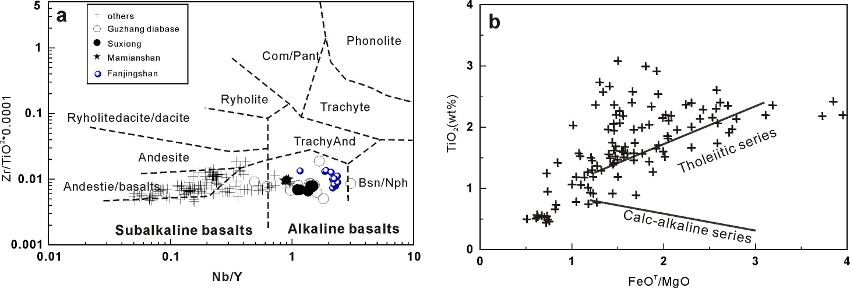
Figure 6: (a) Nb/Y vs. Zr/TiO2×0.0001 diagram distinguishing sub-alkaline and alkaline basalts; (b) FeOT/MgO vs. SiO2 diagram distinguishing tholeiitic and calc- alkaline series.
Geodynamic model
Coeval Neoproterozoic plume events appear to be widespread across a number of continents during Rodinia time (e.g., Li et al., 2003c, 2008c; Ernst et al., 2008). Li et al. (2003c, 2008c) proposed that a mantle superplume beneath Rodinia was responsible for the widespread, and long-lasting (~100 Ma) magmatic events over Rodinia that eventually caused the breakup of the supercontinent. We use Figure 7 to illustrate a plume model for 825-750 Ma magmatic rocks in South China.
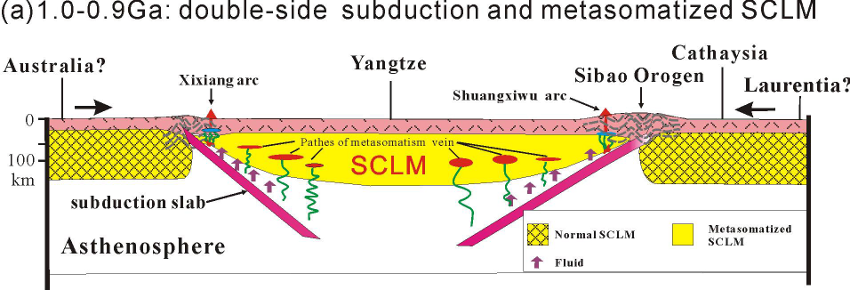
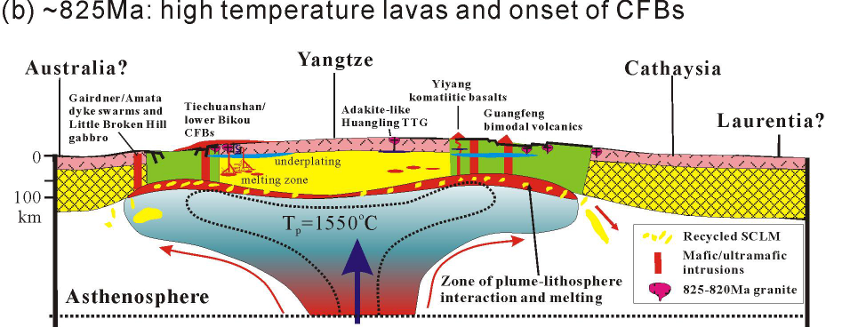
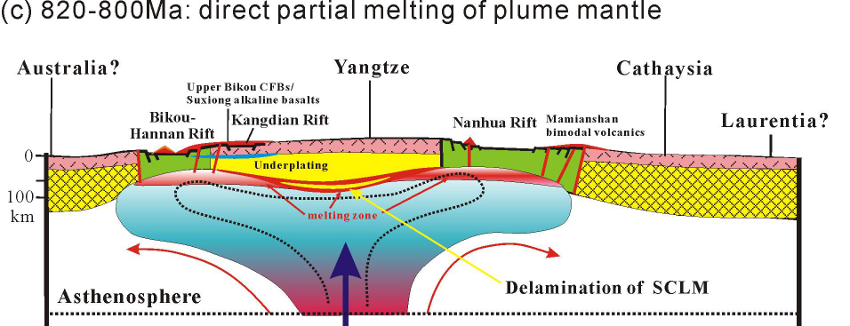
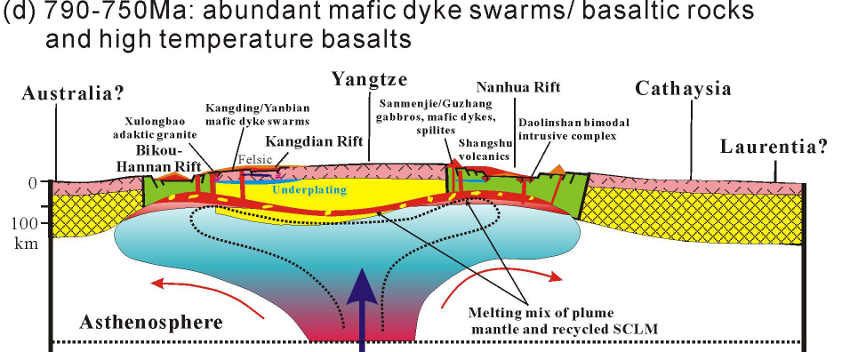
Figure 6: Geodynamic for early Neoproterozoic South China (modified after (Li et al., 1999; Wang et al., 2009)
References
Ernst, R.E., Wingate, M.T.D., Buchan, K.L., Li, Z.X., 2008. Global record of 1600-700 Ma Large Igneous Provinces (LIPs): Implications for the reconstruction of the proposed Nuna (Columbia) and Rodinia supercontinents. Precambrian Res. 160, 159-178.
Hawkesworth, C.J., Lightfoot, P.C., Fedorenko, V.A., Blake, S., Naldrett, A.J., Doherty, W., and Gorbachev, N.S., 1995, Magma differentiation and mineralisation in the Siberian continental flood basalts: Lithos 34, 61-88.
Herzberg, C., Asimow, P.D., Arndt, N., Niu, Y.L., Lesher, C.M., Fitton, J.G., Cheadle, M.J., Saunders, A.D., 2007. Temperatures in ambient mantle and plumes: Constraints from basalts, picrites, and komatiites. Geochem. Geophys. Geosys. Q02006. doi:10.1029/2006GC001390.
Li, W.X., Li, X.H., Li, Z.X., 2005. Neoproterozoic bimodal magmatism in the Cathaysia Block of South China and its tectonic significance. Precambrian Res. 136, 51-66.
Li, W.X., Li, X.H., Li, Z.X., 2008a. Middle Neoproterozoic syn-rifting volcanic rocks in Guangfeng, South China: petrogenesis and tectonic significance. Geol. Mag. 145, 475-489.
Li, X.H., Li, W.X., Li, Z.X., Liu, Y., 2008b. 850-790 Ma bimodal volcanic and intrusive rocks in northern Zhejiang, South China: A major episode of continental rift magmatism during the breakup of Rodinia. Lithos 102, 341-357.
Li, X.H., Li, Z.X., Ge, W.C., Zhou, H.W., Li, W.X., Liu, Y., Wingate, M.T.D., 2003a. Neoproterozoic granitoids in South China: crustal melting above a mantle plume at ca. 825 Ma? Precambrian Res. 122, 45-83.
Li, X.H., Li, Z.X., Sinclair, J.A., Li, W.X., Carter, G., 2006. Revisiting the "Yanbian Terrane": implications for Neoproterozoic tectonic evolution of the western Yangtze Block, South China. Precambrian Res. 151, 14-30.
Li, X.H., Li, Z.X., Sinclair, J.A., Li, W.X., Carter, G., 2007. Reply to the comment by Zhou et al. on: "Revisiting the "Yanbian Terrane": Implications for Neoproterozoic tectonic evolution of the western Yangtze Block, South China" - [Precambrian Res. 151 (2006) 14-30] - [Precambrian Res. 154 (2007) 153-157]. Precambrian Res. 155, 318-323.
Li, X.H., Li, Z.X., Zhou, H., Liu, Y., Kinny, P.D., 2002. U-Pb zircon geochronology, geochemistry and Nd isotopic study of Neoproterozoic bimodal volcanic rocks in the Kangdian Rift of South China; implications for the initial rifting of Rodinia. Precambrian Res. 113, 135-154.
Li, X.H., Li, Z.X., Zhou, H., Liu, Y., Liang, X., Li, W., 2003b. SHRIMP U-Pb zircon age, geochemistry and Nd isotope of the Guandaoshan pluton in SW Sichuan: petrogenesis and tectonic significance. Sci. China (D) 46 (Supp.), 73-83.
Li, Z.X., Bogdanova, S.V., Collins, A.S., Davidson, A., De Waele, B., Ernst, R.E., Fitzsimons, I.C.W., Fuck, R.A., Gladkochub, D.P., Jacobs, J., Karlstrom, K.E., Lu, S., Natapov, L.M., Pease, V., Pisarevsky, S.A., Thrane, K., Vernikovsky, V., 2008c. Assembly, configuration, and break-up history of Rodinia: A synthesis. Precambrian Res. 160, 179-210.
Li, Z.X., Evans, D.A.D., Zhang, S., 2004. A 90º Spin on Rodinia: Possible causal links between the Neoproterozoic supercontinent, superplume, true polar wander and low-latitude glaciation. Earth Planet. Sci. Lett. 220, 409-421.
Li, Z.X., Li, X.H., Kinny, P.D., Wang, J., 1999. The breakup of Rodinia: did it start with a mantle plume beneath South China? Earth Planet. Sci. Lett. 173, 171-181.
Li, Z.X., Li, X.H., Kinny, P.D., Wang, J., Zhang, S., Zhou, H., 2003c. Geochronology of Neoproterozoic syn-rift magmatism in the Yangtze Craton, South China and correlations with other continents: evidence for a mantle superplume that broke up Rodinia. Precambrian Res. 122, 85-109.
Lin, G.C., Li, X.H., Li, W.X., 2007. SHRIMP U-Pb zircon age, geochemistry and Nd-Hf isotope of Neoproterozoic mafic dyke swarms in western Sichuan: Petrogenesis and tectonic significance. Sci. China (D)-Earth Sci. 50, 1-16.
Ling, W.L., Gao, S., Zhang, B.R., Li, H.M., Liu, Y., Cheng, J.P., 2003. Neoproterozoic tectonic evolution of the northwestern Yangtze craton, South China: implications for amalgamation and break-up of the Rodinia Supercontinent. Precambrian Res. 122, 111-140.
Liu, H., 1991. Chapter 4 Correlation of Sinian system. The Sinian System in China. Science Press, Beijing, 126-170 pp.
McCulloch, M.T., Gamble, J.A. 1991. Geochemical and geodynamical conatraints on subduction zone magmatism. Earth Planet. Sci. Lett. 102, 358-374.
Puffer, J.H., 2001. Contrasting high field strength element contents of continental flood basalts from plume versus reactivated-arc sources. Geology 29, 675-678.
Sinclair, J.A., 2001. Petrology, geochemistry, and geochronology of the "Yanbian ophiolite suite", South China: implications for the western extension of the Sibao Orogen. Honours Thesis, Thesis, The University of Western Australia, Perth, 69 pp. (plus appendixes).
Turner, S., and Hawkesworth, C., 1995, The nature of the sub-continental mantle: constraints from the major-element composition of continental flood basalts: Chem. Geol. 120, 295-314.
Wang, H., Mo, X., 1995. An outline of the tectonic evolution of China. Episodes 18, 6-16.
Wang, J., Li, Z.X., 2003. History of Neoproterozoic rift basins in South China: implications for Rodinia break-up. Precambrian Res. 122, 141-158.
Wang, X.C., Li, X.H., Li, W.X., Li, Z.X., 2009. Variable involvements of mantle plumes in the genesis of mid-Neoproterozoic basaltic rocks in South China: A review. Gondwana Res. 15, 381-395.
Wang, X.C., Li, X.H., Li, W.-X., Li, Z.X., Liu, Y., Yang, Y.H., Liang, X.R., Tu, X.L., 2008. The Bikou basalts in the northwestern Yangtze block, South China: Remnants of 820-810 Ma continental flood basalts. Geol. Soc. Am. Bull. 120, 1478-1492.
Wang, X.C., Li, X.H., Li, W.X., Li, Z.X., 2007. Ca. 825 Ma komatiitic basalts in South China: First evidence for > 1500°C mantle melts by a Rodinian mantle plume. Geology 35, 1103-1106.
Wang, X.L., Zhou, J.C., Qiu, J.S., Zhang, W.L., Liu, X.M., Zhang, G.L., 2006. LA-ICP-MS U-Pb zircon geochronology of the Neoproterozoic igneous rocks from Northern Guangxi, South China: Implications for tectonic evolution. Precambrian Res. 145, 111-130.
Zhou, J.C., Wang, X.L., Qiu, J.S., 2009. Geochronology of Neoproterozoic mafic rocks and sandstones from northeastern Guizhou, South China: Coeval arc magmatism and sedimentation. Precambrian Res. 170, 27-42.
Zhou, J., Li, X.H., Ge, W., Li, Z.X., 2007. Age and origin of middle Neoproterozoic mafic magmatism in southern Yangtze Block and relevance to the break-up of Rodinia. Gondwana Res. 12, 184-197.
Zhou, M., Kennedy, A.K., Sun, M., Malpas, J., Lesher, C.M., 2002a. Neoproterozoic arc-related mafic intrusions along the northern margin of South China; implications for the accretion of Rodinia. J. Geol. 110, 611-618.
Zhou, M.F., Kennedy, A.K., Sun, M., Malpas, J., Lesher, C.M., 2002b. Neoproterozoic Arc-Related Mafic Intrusions along the Northern Margin of South China: Implications for the Accretion of Rodinia. J. Geol. 110, 611-618.
Zhou, M.F., Ma, Y.X., Yan, D.P., Xia, X.P., Zhao, J.H., Sun, M., 2006. The Yanbian terrane (Southern Sichuan Province, SW China): A neoproterozoic are assemblage in the western margin of the Yangtze block. Precambrian Res. 144, 19-38.
Zhu, W.G., Zhong, H., Deng, H.L., Wilson, A.H., Liu, B.G., Li, C.Y., Qin, Y., 2006. SHRIMP zircon U-Pb age, geochemistry, and Nd-Sr isotopes of the Gaojiacun mafic-ultramafic intrusive complex, Southwest China. Int. Geol. Rev. 48, 650-668.
